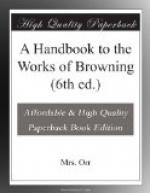Personae.”) 1864.
“At the Mermaid.” }
“House.” }
“Shop.” } “Pacchiarotto, and other
“Pisgah Sights,” I. and II. } Poems.” 1876.
“Bifurcation.” }
“Epilogue.” }
The first and fourth of these are significant from the insight they give into Mr. Browning’s conception of art. We must allow, in reading them, for the dramatic and therefore temporary mood in which they were written, and deduct certain utterances which seem inconsistent with the breadth of the author’s views. But they reflect him truly in this essential fact, that he considers art as subordinate to life, and only valuable in so far as it expresses it. This means, not that his standard is realistic: but that it is entirely human; it could scarcely be otherwise in a mind so devoted to the study of human life; but these very poems display also, on Mr. Browning’s part, a loving familiarity with the works of painters, sculptors, and musicians, and a practical understanding of them, which might easily have resulted in a partial acceptance of artistic standards as such, and of the policy of art for art; and it is only through the breadth and strength of his dramatic genius, that artistic sympathies in themselves so strong could be subjected to it.
In music, this position appears at first sight to be reversed; for Mr. Browning rejects the dramatic theory which would convert it into a direct expression of human thought. Here, however, the poet in him comes into play. He leaves the plastic arts to express what may be both felt and thought; and calls on music to express what may be felt but not thought. In this sense he accepts it as an independent science subject to its own ideals and to its own laws. But this only means that, in his opinion, the relation of music to human life is different from that of plastic art: the one revealing the unknown, while the other embodies what is known.
“OLD PICTURES IN FLORENCE” is a fanciful monologue, spoken as by one who is looking down upon Florence, through her magical atmosphere, from a villa on the neighbouring heights. The sight of her Campanile brings Giotto to his mind; and with Giotto comes a vision of all the dead Old Masters who mingle in spirit with her living men. He sees them each haunting the scene of his former labours in church or chapter-room, cloister or crypt; and he sees them grieving over the decay of their works, as these fade and moulder under the hand of time. He is also conscious that they do not grieve for themselves. Earthly praise or neglect cannot touch them more. But they have had a lesson to teach; and so long as the world has not learnt the lesson, their souls may not rest in heaven.




